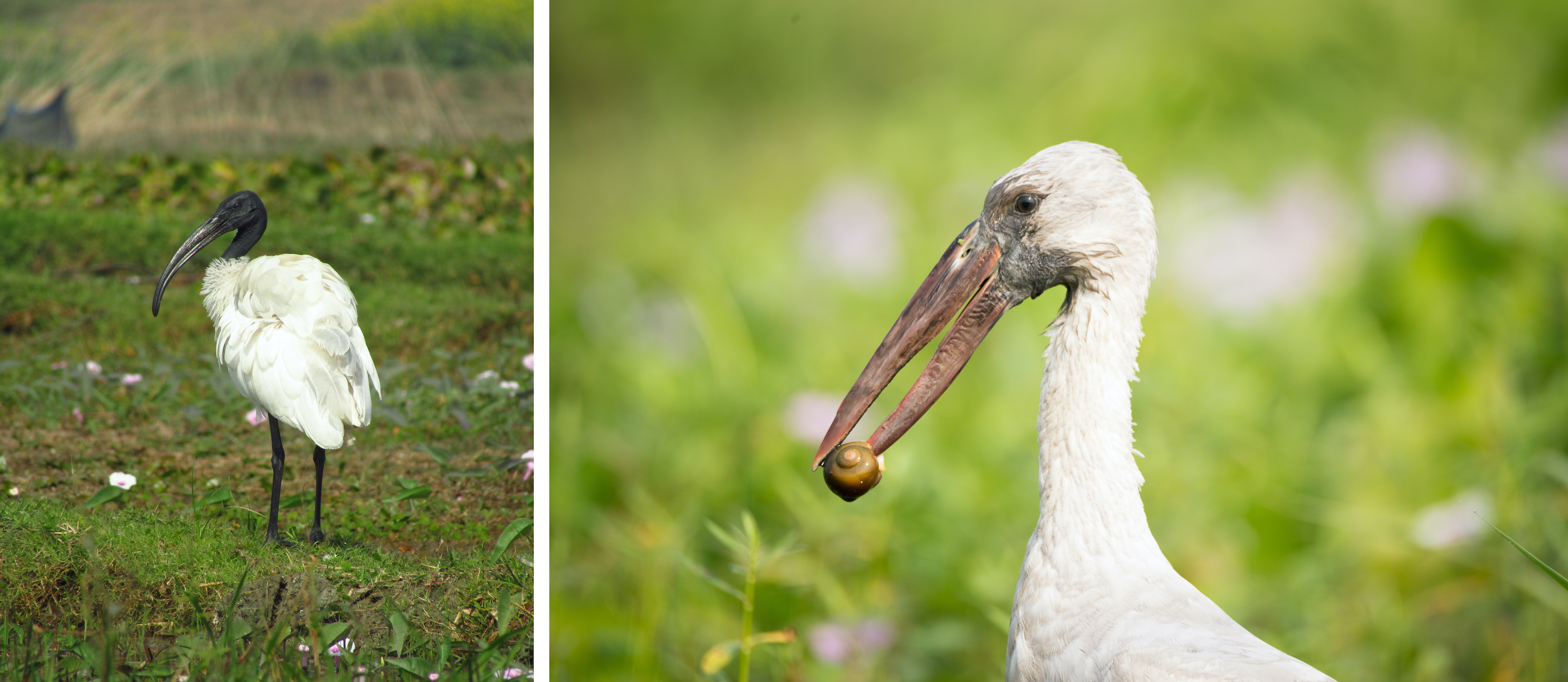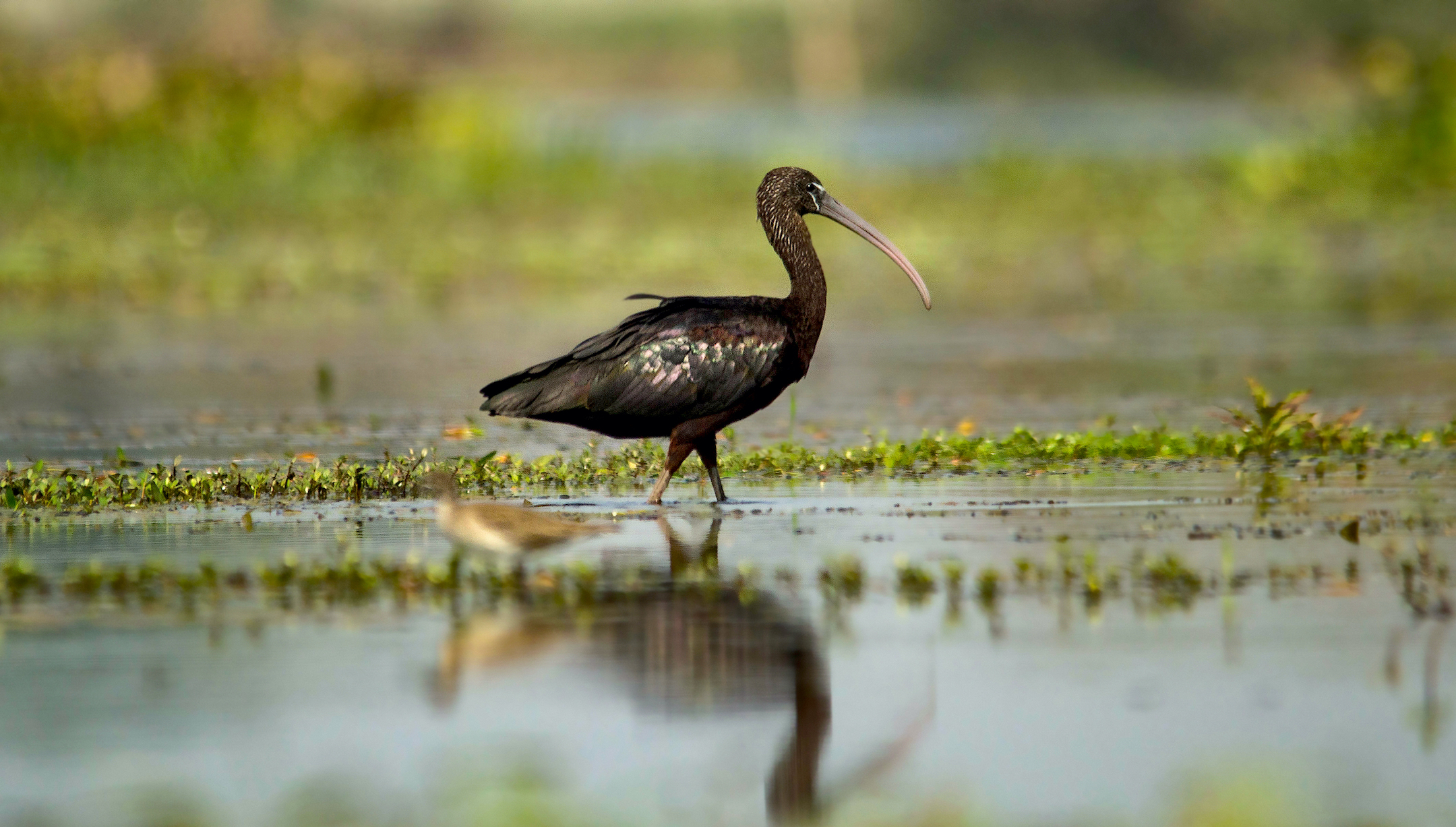 Listen to this article
•
15:34 min
Listen to this article
•
15:34 min
I must have been the only birding enthusiast from Kolkata who had not yet visited Purbasthali village. Every birder I know who heard about my forthcoming trip had a list of ‘must-see” species, starting with the pochard, followed by osprey, ibis, lapwing, sandpiper — the list went on. I wondered if it was even possible to sight so many species on a single trip to the lake. I could not wait to find out.
After a bumpy, five-hour drive from Kolkata, we halted before the iron gate of our guest house, overlooking a 3.5 sq-km lake. As the rev of the engine died, I recognised a familiar wheezy call — the lesser whistling duck, an abundant species and one of the water birds that winters on this lake. The ducks are also a common sight at Santragachi Jheel and Central Park in Kolkata.

Cover photo: A glossy ibis wades through the waters of the lake near Purbasthalivillage, West Bengal. Members of the ibis species are distinguished by their long, downward-curving beak, which they use to muddle the shallow waterbed for crustaceans and aquatic bugs. Cover photo: Bandhan Srimani
Purbasthali village in West Bengal’s Purba Burdhaman district is situated 120 km from Kolkata city. It lies in the rich, alluvial flood plain of the Damodar and Ganga rivers. Besides forming an oxbow lake (a crescent-shaped waterbody), the meandering Ganga has also created a number of small islands of varied sizes, called the Purbasthali Gangetic Isle Complex. A combination of wetland, agricultural fields and tall trees of the surrounding orchards make it favourable for birds, especially migratory species that seek optimal feeding grounds, roosting and resting habitats. Birds like the near-threatened ferruginous pochard, the gorgeous red-crested pochard and the vulnerable common pochard (rarely seen in Kolkata) are sighted here every winter.
The best way to enjoy avian company is to take a boat ride on the lake. We set out post- lunch and saw birds at every turn. Resident species like bronze-winged jacana, common coot and purple moorhen didn’t even bother to lift their heads and continued foraging for insects and invertebrates on the floating surface vegetation. Nearby, two winter migratory gadwalls enjoyed some alone time, and further up the lake a mixed flock — gregarious grey-headed lapwings, cotton pygmy geese, a few wood sandpipers and little grebe — foraged together.

While I watched them go about their business, a flock of some 25 birds with their graceful necks outstretched, flew overhead in a V formation. Their iridescent, bottle-green sheen and reddish-brown tinted bodies appeared lacklustre in the dying sunrays, but that sickle-shaped bill was unmistakable. It was the glossy ibis (Plegadis falcinellus), the most widespread among the species of ibis ranging from Asia, Africa, Australia, Europe, parts of the Caribbean, and the Atlantic.
The glossy ibis — sometimes confused with the similar looking Indian black ibis — is a resident in the western part of India. In winter, this mid-size bird measuring between 48-66 cm, with a maximum wingspan of around 105 cm, is seen in shallow water and on the banks of the lake in Purbasthali, feeding on aquatic beetles, molluscs, and crustaceans alongside other migrant and resident bird species.
The following morning at 6 am, it was still foggy, and our birding kicked off with three radiant little green bee-eaters perched on a wire. Since the ferruginous pochard was yet to arrive from Eurasia, Haridas Mondal, our boatman was keen to show me the osprey. But the raptor’s territory was a good two-hour boat ride away, and after sighting the flock of glossy ibis the previous evening, I was keen to photograph them. I had also made inquiries about a few black-headed ibis in the vicinity, but judging from Mondal’s expression, the ibis was an unpopular choice.
Perhaps because neither the black-headed ibis nor glossy ibis have inspired legends, like the African sacred ibis, considered the living incarnation of the ancient Egyptian god Thoth. Or the endangered northern bald ibis that is believed to be among the first birds to be released by Noah after the biblical flood. They aren’t even popular like Sebastian, the American white ibis and mascot of The University of Miami. These birds are seen across India, stooped in paddy fields by the roadside, probing for food in urban garbage dumps, irrigation canals, lakes, ponds, and reservoirs, or nesting and roosting near fresh and saltwater marshes, and yet, they remain an impressive sight.
When the morning fog gradually dissipated, Mondal and I saw four pheasant-tailed jacana and two glossy ibis. Further ahead — behind a mixed flock of Asian openbill, lesser whistling ducks, and white-breasted waterhen — a conspicuously large wading bird with a black head, contrasting white body and long black legs, took slow, fluid strides in the shallow water. With its down-curved black beak, the black-headed ibis delicately probed for molluscs, larvae of insects, crustaceans and the like, its favourite diet.

The black-headed ibis (Threskiornis melanocephalus) is native to India, and most of the Indian subcontinent, along with China, Cambodia, Hong Kong, Indonesia, Malaysia, Philippines, Myanmar, the Russian Federation, Vietnam, and Thailand. It belongs to the Threskiornithidae family, alongside the Australian white ibis, African sacred ibis, Malagasy sacred ibis, and straw-necked ibis. The black-headed ibis falls under Schedule IV of Indian Wildlife Protection Act (1972) and is categorised as ‘near threatened’ on the IUCN red list. A conjunction of unfavourable circumstance like hunting, trade, agricultural pollution, and destruction and degradation of habitat are thought to be the main reasons for its declining numbers.
The black-headed ibis is starkly dissimilar in appearance from the glossy ibis. It is around 65-76 cm long, and has a slightly larger wingspan of 130 cm. But these two species share some common behaviour traits. They enjoy similar feeding habitats and diet. Both roost in colonies and use twigs to build nests in low trees, sometimes even in bushes, mostly near wetlands. When nesting in mixed species colonies, black-headed ibis prefer to nest separate from other aquatic birds or in heronries (breeding colonies of herons). Although able to use a wide range of habitats, the black-headed ibis is predominantly a wetland species.
Unfortunately, the ibis finds its preferred habitat under enormous strain. In a report on the avifaunal diversity of the Purbasthali region, published in the International Journal of Science and Research (IJSR), Santanu Chowdhury mentions human activities like agricultural practices, livestock grazing and submerged fishing nets as threats to the birds of this lake. In addition to this, the banks are increasingly being converted to agricultural land, and the river channel to the lake is clogged with sedimentation, threatening to cut off its fresh water source.

We encountered another problem too. A profusion of water hyacinth (widely called the Terror of Bengal) and submerged aquatic plants obstructed our boat as we tried to get closer to photograph the ibis. Mondal reassured me that in a few weeks, the fishermen would clear them up — an annual practice to prevent the lake from getting completely choked, since locals rely on the lake for fish.
So I did not get a chance to photograph the elegant ibis’, but I did not have the time to feel disappointed either, not at this lake surrounded by birds. I turned my attention and camera, and focussed on a purple heron. Another first sighting for me.







